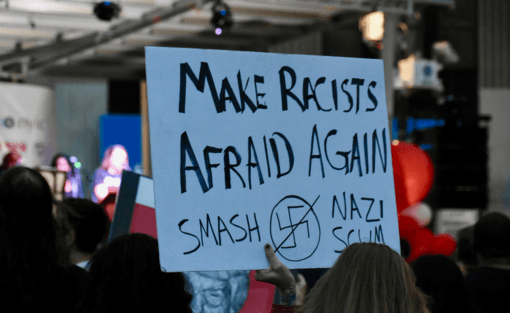
Photo by Alec Perkins | CC BY 2.0
Here in Massachusetts we need to pay careful attention to history illustrated in the iconic photo by Stanley Forman “The Soiling of Old Glory” from April 5, 1976, as an angry counter-protester to school desegregation is seen getting ready to attack a demonstrator fighting for school integration. The reality of segregation in Boston’s public schools was the subject of Jonathan Kozol’s Death at an Early Age (1967).
Those who protest against neofascism realize that democracy is in the streets. Forman’s photo is particularly important today because schools in the U.S. have for all intents and purposes been resegregated. And many who want to return to some mythic and glorified past carry guns to defend that separation and their twisted ideology.
I consider myself fortunate, as I had a psychology professor, Jack Finger, who was one of the expert witnesses who testified in favor of school integration during the 1970s in Boston.
Summer was past its apex on August 19th. Heather Heyer had been killed during a neo-Nazi rally and its aftermath on the streets of Charlottesville, Virginia only a week earlier. In Boston, tens of thousands showed up to protest against a neo-Nazi and neofascist rally on the Boston Common. Even a casual observer of history would admit that the cradle of national government—the incubator of representative democracy—was once again metaphorically present in the church tower with the warning light of a silversmith.
Trump, ever the faux and sunshine patriot, attacked the antifascist and anti-Nazi protesters as “anti-police agitators,” before covering his pathetic tracks in the sand with an observation about the right to protest in the U.S. (“Trump attacks protesters as anti-police agitators,” The Guardian, August 19, 2017).
We pushed back against hate across the state in Pittsfield, Massachusetts where the Berkshires and Taconics and Catskills intertwine to form the foothills of the Appalachians. There were about 300 of us in this city of just over 40,000 people, which had been abandoned by deindustrialization and many were trying to hold onto the basic decency and humanity that informs the history of this place.
People were talking to one another, as they often do at the demonstrations that have arisen in response to the neofascism of Trump and Company. Bannon was gone, but Gorka and Miller remained, as did McMaster with the beginning of a plan to renew another troop surge into the devastation that has been visited on Afghanistan. And they were making plans for other interventions in other places.
The mix of humanity in the crowd of protesters was ennobling: Gays and lesbians and blacks and whites and Latinos and Jews and Christians and Muslims. Here was the nation in miniature. There was a police presence that I have not seen at protests in this area before. I think that Charlottesville was on all minds.
Park Square, in the heart of the city, was lavished with the well wishes of passersby in cars, trucks, including many in tractor trailers, and motorcyclists. One middle finger and hordes of peace signs were raised.
While the besieged president was uniquely himself, teetering between condemnation and support of the right to protest, I marveled at a piece in The Guardian by a former foreign affairs correspondent and columnist, Simon Tisdall (“A letter to my American friends: when did the dream die,” August 19, 2017), where that writer recycles much of the myth about when Trump happened upon the U.S. political scene and everything suddenly went wrong overnight.
Tisdall wrote about attending an event at the White House in 1992 on the South Lawn when George H.W. Bush was president. Bush “was extolling the virtues of American fitness,” and the writer “finally took America to my heart.” Perhaps Tisdall missed the unemployment rate of 7.8 % in 1992, the unofficial and under reported poverty rate of 14.2%, or the “turkey shoot” that one pilot observed in 1991 as Iraqi forces were shot from the air as they fled Kuwait. Perhaps also missed was the Iranian passenger flight that was shot out of the air in 1988, killing its 290 passengers. George H.W. Bush, then the vice president, said that he would “never apologize for the United States of America. Ever. I don’t care what the facts are.” Or maybe also missed was the death and destruction in Panama as part of “Operation Just Cause” that killed an untold number of civilians with an onslaught of 24,000 U.S. troops, intervening in a nation that posed no credible threat to the U.S.
Here is Tisdall again on the administration of George H. W. Bush:
Yet Bush’s actions were instructive in other, more presidentially symbolic ways. They spoke to his sense of a free people joined together in a voluntary, mutually supportive union. For him, “one nation under God, indivisible, with liberty and justice for all”, to quote the Pledge of Allegiance, was no trite slogan. It was a living, vital principle.
Being on the streets in protest in the face of such hyperbole is the only place to be!